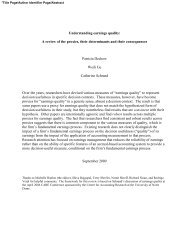Nike Considered: Getting Traction on Sustainability - MIT Sloan ...
Nike Considered: Getting Traction on Sustainability - MIT Sloan ...
Nike Considered: Getting Traction on Sustainability - MIT Sloan ...
You also want an ePaper? Increase the reach of your titles
YUMPU automatically turns print PDFs into web optimized ePapers that Google loves.
NIKE CONSIDERED: GETTING TRACTION ON SUSTAINABILITY<br />
Rebecca Henders<strong>on</strong>, Richard M. Locke, Christopher Lyddy, Cate Reavis<br />
Performance and Aesthetics<br />
There were a number of performance and aesthetic risks that <str<strong>on</strong>g>Nike</str<strong>on</strong>g> footwear faced in using EPMs such<br />
as synthetic leather. There was a potential performance risk, for example, that using recycled c<strong>on</strong>tent<br />
could degrade physical properties like material durability, threatening <str<strong>on</strong>g>Nike</str<strong>on</strong>g>’s strict quality standards.<br />
Jim Ford, Product Creati<strong>on</strong> Director in the Cleated category, described that with some EPM synthetic<br />
leather alternatives, the opti<strong>on</strong>s weren’t very attractive: “Leathers look boardy and dry, and the<br />
textiles aren’t very interesting.”<br />
Moreover, there wasn’t always an EPM substitute that mimicked the performance and aesthetics of<br />
n<strong>on</strong>-EPM equivalents. For example, while <str<strong>on</strong>g>Nike</str<strong>on</strong>g> had devoted itself to eliminating toxic solvents from<br />
producti<strong>on</strong>, in some cases they remained an essential ingredient in producing secure b<strong>on</strong>ds. <str<strong>on</strong>g>Nike</str<strong>on</strong>g>’s<br />
products with plastic sole comp<strong>on</strong>ents – including cleats for global and American football and<br />
baseball, and plastic housings for the <str<strong>on</strong>g>Nike</str<strong>on</strong>g>+ running performance tracking chip 24 – all required<br />
solvent usage for b<strong>on</strong>ding.<br />
Design<br />
In most cases, <str<strong>on</strong>g>C<strong>on</strong>sidered</str<strong>on</strong>g> made the design process more complex. While designers liked to<br />
iteratively find the right design, <str<strong>on</strong>g>C<strong>on</strong>sidered</str<strong>on</strong>g> required thinking about pattern efficiency much earlier in<br />
the process. It required more planning, often took l<strong>on</strong>ger, and it was often harder to find designs that<br />
both looked “cool” and were efficient. “On most product decisi<strong>on</strong>s, it’s not lower in cost, better in<br />
performance, and more sustainable,” explained <strong>on</strong>e category product director. “If it was that easy,<br />
that’d be great! So usually <strong>on</strong> every comp<strong>on</strong>ent of a shoe, there are tough decisi<strong>on</strong>s to be made.” As a<br />
designer within the Cleated category noted, “We try to make designs look cool first, then run it by<br />
other filters like cost and <str<strong>on</strong>g>C<strong>on</strong>sidered</str<strong>on</strong>g>. We design in resp<strong>on</strong>se to a lot of c<strong>on</strong>straints, like price and<br />
performance requirements, and goals like cool looks and feel. More c<strong>on</strong>straints makes the process<br />
harder and, maybe, slower.”<br />
Time<br />
Given the extremely fast pace of product development in resp<strong>on</strong>se to c<strong>on</strong>sumer trends and <strong>on</strong>going<br />
organizati<strong>on</strong>al change efforts, product creati<strong>on</strong> employees had scarce time for implementing<br />
<str<strong>on</strong>g>C<strong>on</strong>sidered</str<strong>on</strong>g>. Above these standard pressures, staff in the Women’s Training (WT) category were even<br />
further c<strong>on</strong>strained. WT had been struggling to shift its design focus from a late-20s dance-oriented<br />
c<strong>on</strong>sumer to a mid-teens sports-oriented c<strong>on</strong>sumer, leading to upheaval in its product line. WT<br />
experienced c<strong>on</strong>tinual pers<strong>on</strong>nel losses in its development functi<strong>on</strong>, leading to persistent<br />
understaffing in the triad role with greatest <str<strong>on</strong>g>C<strong>on</strong>sidered</str<strong>on</strong>g> resp<strong>on</strong>sibilities. One WT developer reported<br />
that she <strong>on</strong>ce needed to create 40 BOMs in two days <strong>on</strong> a deadline – 20 or 25 a seas<strong>on</strong> was more<br />
typical – just to meet her regular product resp<strong>on</strong>sibilities. During those very late days, she had no<br />
24<br />
<str<strong>on</strong>g>Nike</str<strong>on</strong>g>+ was a small chip inserted into the sole of <str<strong>on</strong>g>Nike</str<strong>on</strong>g> running shoes that tracked running performance, informati<strong>on</strong> to compare via the<br />
runner’s iPod and internet with other runners’ data.<br />
January 21, 2009 12
















